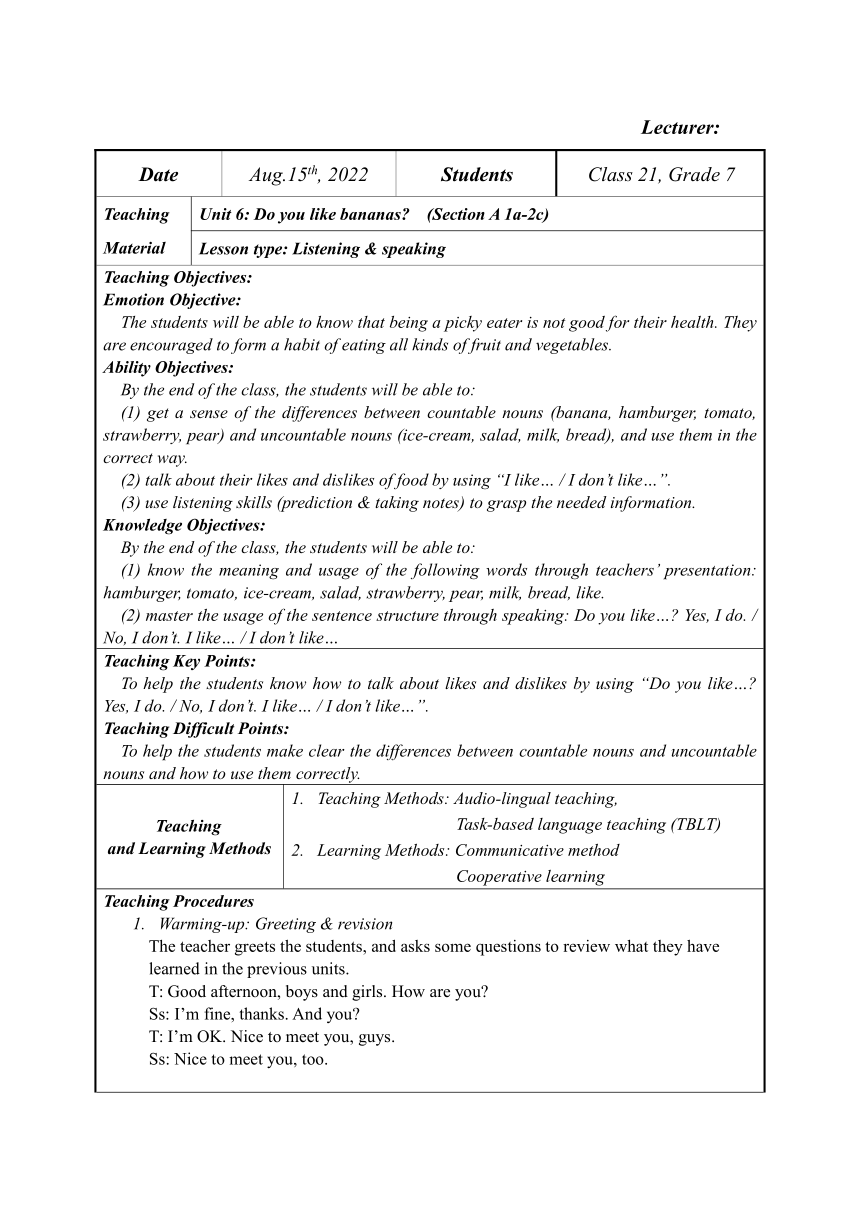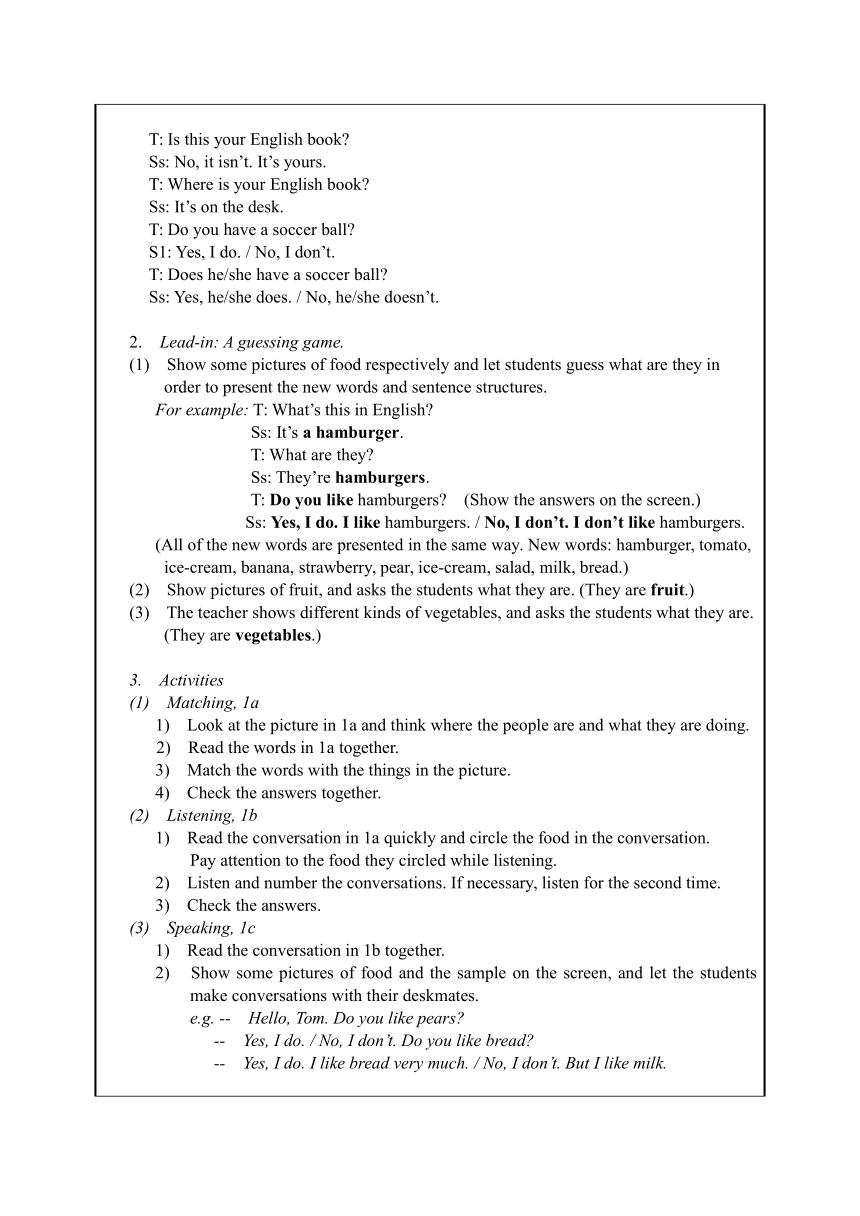人教版英语七年级上册 Unit 6 Do you like bananas? (Section A 1a-2c) 表格式教案
文档属性
| 名称 | 人教版英语七年级上册 Unit 6 Do you like bananas? (Section A 1a-2c) 表格式教案 |  | |
| 格式 | doc | ||
| 文件大小 | 40.5KB | ||
| 资源类型 | 教案 | ||
| 版本资源 | 人教新目标(Go for it)版 | ||
| 科目 | 英语 | ||
| 更新时间 | 2022-08-11 23:17:12 | ||
图片预览


文档简介
Lecturer:
Date Aug.15th, 2022 Students Class 21, Grade 7
Teaching Material Unit 6: Do you like bananas (Section A 1a-2c)
Lesson type: Listening & speaking
Teaching Objectives:Emotion Objective:The students will be able to know that being a picky eater is not good for their health. They are encouraged to form a habit of eating all kinds of fruit and vegetables.Ability Objectives:By the end of the class, the students will be able to:(1) get a sense of the differences between countable nouns (banana, hamburger, tomato, strawberry, pear) and uncountable nouns (ice-cream, salad, milk, bread), and use them in the correct way.(2) talk about their likes and dislikes of food by using “I like… / I don’t like…”.(3) use listening skills (prediction & taking notes) to grasp the needed information.Knowledge Objectives: By the end of the class, the students will be able to:(1) know the meaning and usage of the following words through teachers’ presentation: hamburger, tomato, ice-cream, salad, strawberry, pear, milk, bread, like.(2) master the usage of the sentence structure through speaking: Do you like… Yes, I do. / No, I don’t. I like… / I don’t like…
Teaching Key Points: To help the students know how to talk about likes and dislikes by using “Do you like… Yes, I do. / No, I don’t. I like… / I don’t like…”.Teaching Difficult Points: To help the students make clear the differences between countable nouns and uncountable nouns and how to use them correctly.
Teachingand Learning Methods Teaching Methods: Audio-lingual teaching, Task-based language teaching (TBLT)Learning Methods: Communicative method Cooperative learning
Teaching Procedures Warming-up: Greeting & revisionThe teacher greets the students, and asks some questions to review what they have learned in the previous units. T: Good afternoon, boys and girls. How are you Ss: I’m fine, thanks. And you T: I’m OK. Nice to meet you, guys.Ss: Nice to meet you, too.T: Is this your English book Ss: No, it isn’t. It’s yours.T: Where is your English book Ss: It’s on the desk.T: Do you have a soccer ball S1: Yes, I do. / No, I don’t.T: Does he/she have a soccer ball Ss: Yes, he/she does. / No, he/she doesn’t.2. Lead-in: A guessing game.
(1) Show some pictures of food respectively and let students guess what are they in order to present the new words and sentence structures.For example: T: What’s this in English Ss: It’s a hamburger.T: What are they Ss: They’re hamburgers.T: Do you like hamburgers (Show the answers on the screen.)Ss: Yes, I do. I like hamburgers. / No, I don’t. I don’t like hamburgers. (All of the new words are presented in the same way. New words: hamburger, tomato, ice-cream, banana, strawberry, pear, ice-cream, salad, milk, bread.)(2) Show pictures of fruit, and asks the students what they are. (They are fruit.) (3) The teacher shows different kinds of vegetables, and asks the students what they are. (They are vegetables.) 3. Activities(1) Matching, 1a 1) Look at the picture in 1a and think where the people are and what they are doing. 2) Read the words in 1a together. 3) Match the words with the things in the picture. 4) Check the answers together. (2) Listening, 1b 1) Read the conversation in 1a quickly and circle the food in the conversation.
Pay attention to the food they circled while listening. 2) Listen and number the conversations. If necessary, listen for the second time. 3) Check the answers. (3) Speaking, 1c 1) Read the conversation in 1b together. 2) Show some pictures of food and the sample on the screen, and let the students make conversations with their deskmates. e.g. -- Hello, Tom. Do you like pears -- Yes, I do. / No, I don’t. Do you like bread -- Yes, I do. I like bread very much. / No, I don’t. But I like milk. 3) Invite several pairs to show their conversations. 4) On the basis of their presentation, ask the students “Does he/she like … ” 4. Optional activities (1) Listening, 2a1) Let the students read the words in 2a together. 2) Listen and circle the food you hear. 3) Check the answers.(2) listening, 2b1) Shows the pictures in 2b, and asks “What are they talking about ”2) Listen and fill in the blanks.3) Check the answers.4) Role- play the conversation. (3) Speaking. 2c 1) Show picture of food as well as the sentence structures, and encourage the students to practice the conversations with deskmates. Structure1: - Hi, Tom. I like _____. Do you like _____ - Yes, I do. / No, I don’t like _____. Structure2: - Tom, let’s have _____. - On, no. Thanks.- No - Sorry, I don’t like _____. 2) Invite some pairs to show their conversations.5. Conclusion Invite some students to conclude what they’ve learned in this lesson.6. Homework(1) Copy and dictate the new words: banana-bread(2) Exercise book: finish period one.
Blackboard Design:Unit 6 Do you like bananas -Do you like … c.n. (pl.) u.n. food-Yes, I do. hamburgers ice-cream ↓ No, I don’t. tomatoes salad fruit
oranges milk vegetables-Does he/she like… bananas bread-Yes, he/she does. strawberries No, he/she doesn’t. pears
Date Aug.15th, 2022 Students Class 21, Grade 7
Teaching Material Unit 6: Do you like bananas (Section A 1a-2c)
Lesson type: Listening & speaking
Teaching Objectives:Emotion Objective:The students will be able to know that being a picky eater is not good for their health. They are encouraged to form a habit of eating all kinds of fruit and vegetables.Ability Objectives:By the end of the class, the students will be able to:(1) get a sense of the differences between countable nouns (banana, hamburger, tomato, strawberry, pear) and uncountable nouns (ice-cream, salad, milk, bread), and use them in the correct way.(2) talk about their likes and dislikes of food by using “I like… / I don’t like…”.(3) use listening skills (prediction & taking notes) to grasp the needed information.Knowledge Objectives: By the end of the class, the students will be able to:(1) know the meaning and usage of the following words through teachers’ presentation: hamburger, tomato, ice-cream, salad, strawberry, pear, milk, bread, like.(2) master the usage of the sentence structure through speaking: Do you like… Yes, I do. / No, I don’t. I like… / I don’t like…
Teaching Key Points: To help the students know how to talk about likes and dislikes by using “Do you like… Yes, I do. / No, I don’t. I like… / I don’t like…”.Teaching Difficult Points: To help the students make clear the differences between countable nouns and uncountable nouns and how to use them correctly.
Teachingand Learning Methods Teaching Methods: Audio-lingual teaching, Task-based language teaching (TBLT)Learning Methods: Communicative method Cooperative learning
Teaching Procedures Warming-up: Greeting & revisionThe teacher greets the students, and asks some questions to review what they have learned in the previous units. T: Good afternoon, boys and girls. How are you Ss: I’m fine, thanks. And you T: I’m OK. Nice to meet you, guys.Ss: Nice to meet you, too.T: Is this your English book Ss: No, it isn’t. It’s yours.T: Where is your English book Ss: It’s on the desk.T: Do you have a soccer ball S1: Yes, I do. / No, I don’t.T: Does he/she have a soccer ball Ss: Yes, he/she does. / No, he/she doesn’t.2. Lead-in: A guessing game.
(1) Show some pictures of food respectively and let students guess what are they in order to present the new words and sentence structures.For example: T: What’s this in English Ss: It’s a hamburger.T: What are they Ss: They’re hamburgers.T: Do you like hamburgers (Show the answers on the screen.)Ss: Yes, I do. I like hamburgers. / No, I don’t. I don’t like hamburgers. (All of the new words are presented in the same way. New words: hamburger, tomato, ice-cream, banana, strawberry, pear, ice-cream, salad, milk, bread.)(2) Show pictures of fruit, and asks the students what they are. (They are fruit.) (3) The teacher shows different kinds of vegetables, and asks the students what they are. (They are vegetables.) 3. Activities(1) Matching, 1a 1) Look at the picture in 1a and think where the people are and what they are doing. 2) Read the words in 1a together. 3) Match the words with the things in the picture. 4) Check the answers together. (2) Listening, 1b 1) Read the conversation in 1a quickly and circle the food in the conversation.
Pay attention to the food they circled while listening. 2) Listen and number the conversations. If necessary, listen for the second time. 3) Check the answers. (3) Speaking, 1c 1) Read the conversation in 1b together. 2) Show some pictures of food and the sample on the screen, and let the students make conversations with their deskmates. e.g. -- Hello, Tom. Do you like pears -- Yes, I do. / No, I don’t. Do you like bread -- Yes, I do. I like bread very much. / No, I don’t. But I like milk. 3) Invite several pairs to show their conversations. 4) On the basis of their presentation, ask the students “Does he/she like … ” 4. Optional activities (1) Listening, 2a1) Let the students read the words in 2a together. 2) Listen and circle the food you hear. 3) Check the answers.(2) listening, 2b1) Shows the pictures in 2b, and asks “What are they talking about ”2) Listen and fill in the blanks.3) Check the answers.4) Role- play the conversation. (3) Speaking. 2c 1) Show picture of food as well as the sentence structures, and encourage the students to practice the conversations with deskmates. Structure1: - Hi, Tom. I like _____. Do you like _____ - Yes, I do. / No, I don’t like _____. Structure2: - Tom, let’s have _____. - On, no. Thanks.- No - Sorry, I don’t like _____. 2) Invite some pairs to show their conversations.5. Conclusion Invite some students to conclude what they’ve learned in this lesson.6. Homework(1) Copy and dictate the new words: banana-bread(2) Exercise book: finish period one.
Blackboard Design:Unit 6 Do you like bananas -Do you like … c.n. (pl.) u.n. food-Yes, I do. hamburgers ice-cream ↓ No, I don’t. tomatoes salad fruit
oranges milk vegetables-Does he/she like… bananas bread-Yes, he/she does. strawberries No, he/she doesn’t. pears
同课章节目录
- starters 预备篇(2012秋审查)
- Unit 1 Good morning !
- Unit 2 What’s this in English?
- Unit 3 What color is it ?
- Unit 1 My name's Gina.
- Section A
- Section B
- Unit 2 This is my sister.
- Section A
- Section B
- Unit 3 Is this your pencil?
- Section A
- Section B
- Unit 4 Where's my schoolbag?
- Section A
- Section B
- Unit 5 Do you have a soccer ball?
- Section A
- Section B
- Unit 6 Do you like bananas?
- Section A
- Section B
- Unit 7 How much are these socks?
- Section A
- Section B
- Unit 8 When is your birthday?
- Section A
- Section B
- Unit 9 My favorite subject is science.
- Section A
- Section B
